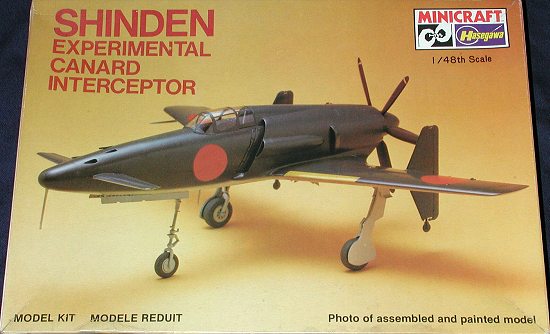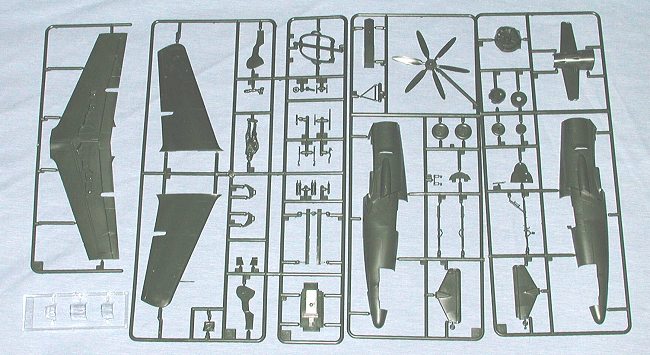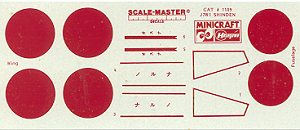
|
KIT: |
Minicraft 1/48 J7W1 Shinden |
|
KIT # |
1189 |
|
PRICE: |
$6.00 when new |
|
DECALS: |
One aircraft |
|
REVIEWER: |
|
|
NOTES: |
Hasegawa mold |

|
HISTORY |
The Kyushu J7W Shinden (Magnificent Lightning), was one of only two canard aircraft to be built and fly during WWII (the other was the XP-55 Ascender). The reason for the rear engined pusher layout was that it was fully intended to replace the reciprocating engine with a turbojet when one became available. In order to test the airframe layout, three all wood MXY6 gliders were built. These started trials in mid1943. To test powered flight, a small four cylinder engine was installed on one of these gliders. The results were satisfactory.
Kyushu was chosen to build the plane as they were relatively unburdened with war work and had the required space. Work started in June of 1944 and the first prototype was completed in ten months. The nose had four 30mm cannon and the pilot sat just forward of the swept wings. The propeller shaft was fitted with an exploding bolt so that the propeller could be jettisoned in case the pilot needed to bail out. The six bladed prop was attached to a 2,100 hp Mitsubishi MK9D 18 cylinder radial engine that was buried in the rear fuselage. Even prior to its first flight, the plane was ordered into production. The end of the war stymied any further development.
First flight was not until 3 August, mostly due to the unavailability of some small items, and problems with engine overheating. Three short flights were made before war's end, totaling 45 minutes. During those flights, problem areas were discovered, the worst being a strong torque pull and some engine vibrations. A second plane was completed but not flown.
Apparently at least one type survived and is in the Smithsonian collection awaiting restoration.
|
THE KIT |

Actually, it is pretty incredible that Hasegawa would produce such an aircraft. It foretold the 'Luft '46' phenomenon by about 20 years or so! The kit is molded in a dark green plastic and has raised panel line detailing. The interior is fairly well detailed and there is also detailing on the interior side walls. The canopy can be displayed in the open position if desired. Detailing in the wheel wells is also quite good. As you might expect, there are a number of ejector pin marks on the smaller pieces such as the inside of gear door, gear struts, wheels and such. Most should be easy to remove. The aircraft will probably be a major tail-sitter so nose weight is recommended. Fortunately, there is room for it. The kit also includes a standing pilot figure.
 Decals are for the prototype, which was unmarked except for common data markings
and insignia. The plane was painted dark green upper with light grey undersides
and yellow IFF stripes on the wing leading edge. Decals are by Scalemaster so
should work well with no problems. The instructions themselves are quite good
and give several logical construction steps. Color information is given as
required, though all references are to generic names.
Decals are for the prototype, which was unmarked except for common data markings
and insignia. The plane was painted dark green upper with light grey undersides
and yellow IFF stripes on the wing leading edge. Decals are by Scalemaster so
should work well with no problems. The instructions themselves are quite good
and give several logical construction steps. Color information is given as
required, though all references are to generic names.
|
CONCLUSIONS |
Overall, this should be a pretty easy build. It isn't state of the art for today, but when it was produced, it was the best that could be engineered. Even today it holds up well and should make into a super model.
|
REFERENCES |
Japanese Aircraft of the Pacific War, R.J. Francillon, 1979
If you would like your product reviewed fairly and quickly by a site that has well over 150,000 visitors a month, please contact me or see other details in the Note to Contributors.